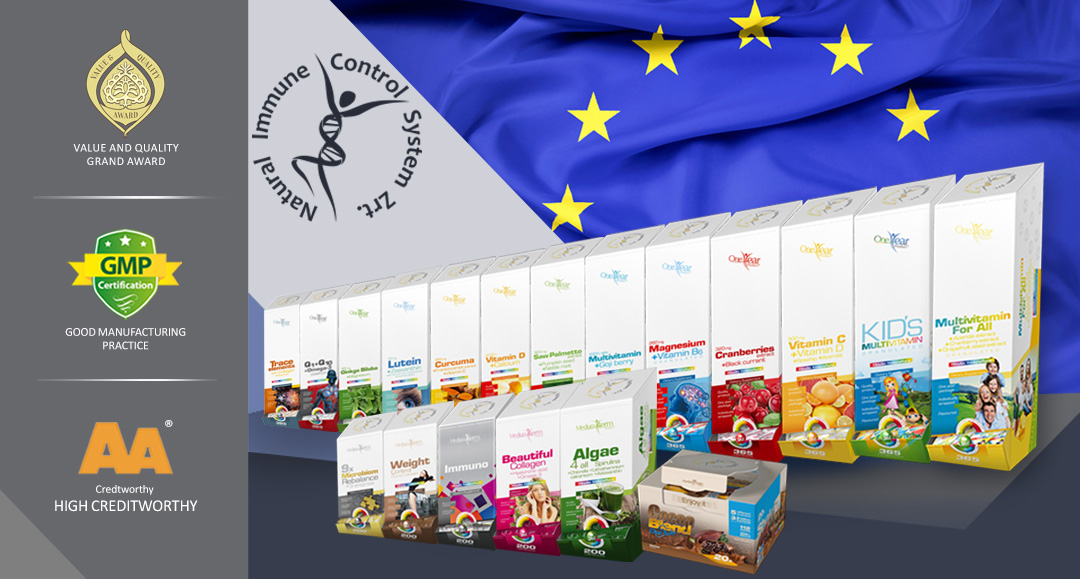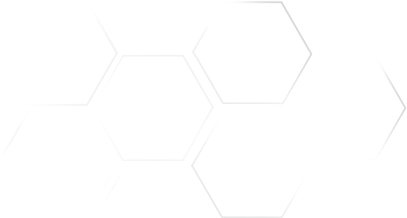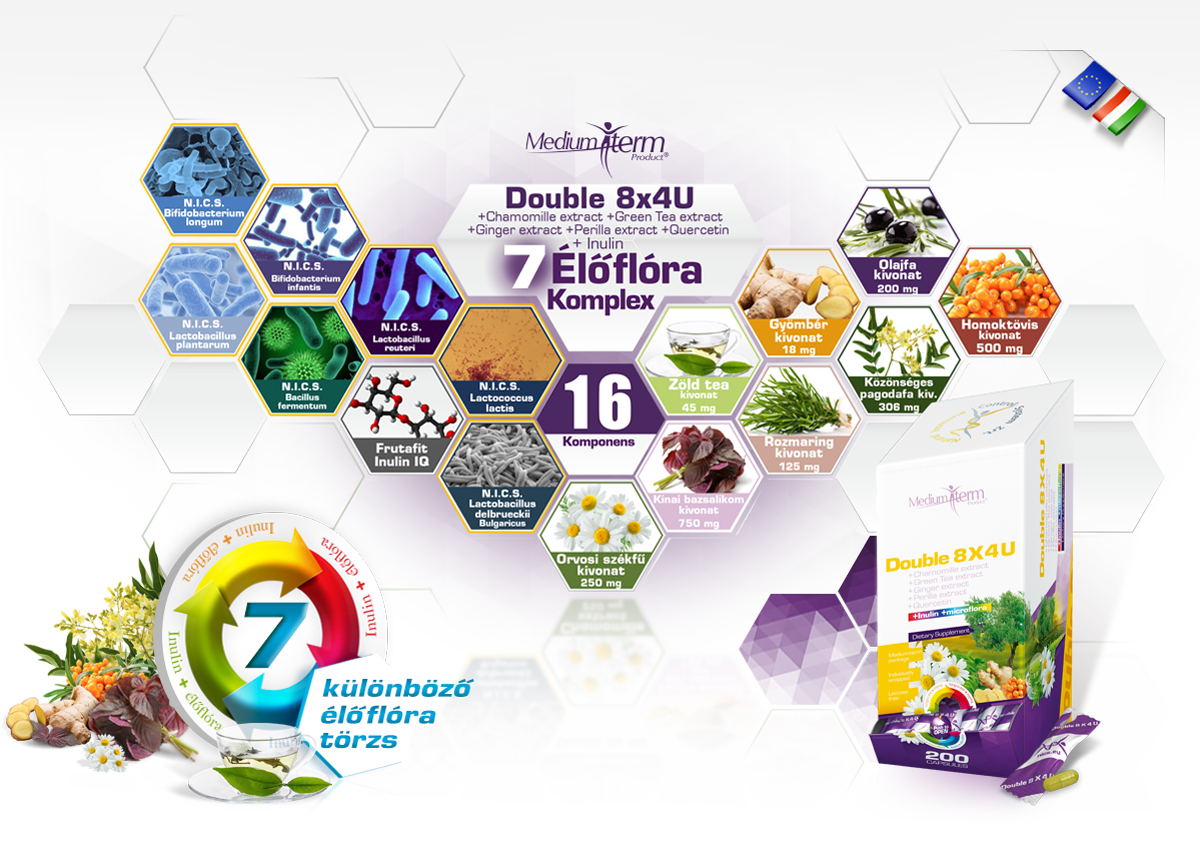|





|
|
Kínai bazsalikom kivonat 750 mg, ebből rozmarinsav 150 mg
|
|
A kínai bazsalikomot Európában sokáig dísznövénynek nevelték, a kínai, koreai, indiai és japán gyógyászatban pedig már évezredekkel ezelőtt használták.
A kínai bazsalikom nevelése, életformája alapvetően nagyon hasonló a ˝hagyományos˝ bazsalikomhoz (Ocimum basilicum L.). A különbségek a növény szemlélése során szinte egyből szembe ötlenek, mivel a levélszél és a levélforma teljesen más a két növénynél. A kínai bazsalikom talán a csalánra hasonlít jobban, s valószínűleg ezért kapta a ˝fekete csalán˝ elnevezést is.
A kínai bazsalikom hazánkban inkább a gyógyászatban használatos. Aromája nagyon kellemes, ami eleinte élénkzöld színű, majd barnás színezetűvé válik. Az íze kissé kámforos hatású.

|
|
Homoktövis kivonat 500 mg, ebből oleánolsav 25 mg
|
|
A homoktövis a Himalája lejtőin termő cserje, amely korunk egyik legértékesebb gyógynövénye. Az ˝egészség tárának˝ is hívják. A homoktövis gyümölcsök gazdagok fehérjékben, szénhidrátokban, szerves savakban, A-, B1-, B2-, B6-, B8-, B9-, C-, K-, P- és E-vitaminban, omega zsírsavakban és nyomelemekben.
|
|
Közönséges pagodafa kivonat 306 mg, ebből quercetin 300 mg
|
|
A japánakác, vagy más néven közönséges pagodafa Kínában őshonos, de előfordul Japánban, Koreában és Vietnámban is, továbbá a növény meghonosodott az Egyesült Államokban és Európában is.
A tradicionális ázsiai népi gyógyászatban évezredek óta ismert és alkalmazott a japánakác (Sophora japonica) a modern fitoterápia számára is értékes gyógynövény. A pillangósvirágúak (Fabaceae) családjába tartozó, akár 15-25 m magasra is megnövő fa szinte minden részét (virág, rügy, levél, kéreg, mag) alkalmazzák a hagyományos gyógyászatban. A növény rügye és virága hivatalos mind a Kínai mind az Európai Gyógyszerkönyvben.
A japánakác jellegzetes tartalomanyagai közé tartoznak a flavonoidok, izoflavonoidok, terpenoidok és alkaloidok. A növény hatásaiért legnagyobb részben flavonoid (pl. rutin, kempferol, quercetin, apigenin) és izoflavonoid (pl. genisztein, genisztin, szoforikozid, orobol) típusú másodlagos anyagcsere termékek a felelősek.
|
|
Orvosi székfű (kamilla) kivonat 250 mg
|
|
A világ egyik legismertebb gyógynövénye: az orvosi székfű más néven kamilla (Matricaria recutita L.), hivatalos a VIII. Magyar Gyógyszerkönyvben, amelynek előírásai megfelelnek az 5. Európai Gyógyszerkönyv minőségi követelményeinek. Az egész világon, így hazánkban is talán a legismertebb és leggyakrabban használt teadrogot szolgáltatja.
A kamilla virágzatai tartalmaznak kék vagy kékeszöld színű illóolajat (legalább 0,4%-ot), flavon-származékokat és egyéb nem illóolajat. A flavon származékok közül legjelentősebb az apigenin, amely szabadon is előfordul a növényben, de glikozidikus kötésben is megtalálható. A virágzatok tartalmaznak kumarinokat és jelentős mennyiségű kolint (kb. 0,3%-ot). A kamilla jótékony hatása nyálkaanyag tartalmával is összefügg.
|
|
Olajfa kivonat 200 mg, ebből oleuropein 80 mg
|
|
Az olajfa termésének és levelének aktív összetevője a glikozid alapú Oleuropein, amely egyfajta fenolos, keserű vegyület. A XX. század elején azonosított értékes anyag az olajfa gyökerében, kérgében, gyümölcsében, levelében egyaránt kimutatható. Az oleuropein jelentősen megnöveli az olajfa ellenálló képességét. Az olajfa kivonat további fontos anyagokat is tartalmaz, így van benne króm, vas, szelén, cink, béta-karotin, C-vitamin, illetve az aminosavak széles skálája.
|
|
Rozmaring kivonat 125 mg, ebből rozmarinsav 12.5 mg
|
|
A rozmaring kivonat rozmaringból (Rosmarinus officinalis Linn.) készül, amely egy általános háztartási növény, amely Földközi-tenger mellékéről származik. A honfoglaló magyarok a Pannóniában élt népektől vették át a középkortól pedig az Alpokban is termesztették, de ma már az egész világon megtalálható.
Benne lévő hatóanyagok
Illóolaj: borneol, kámfor, α- pinének, keserűanyagok (karnazol), flavonoidok (luteolin, diosmin, hesperitin), lamiaceae csersav. Urzolsav, rozmarinsav, klorogénsav, kávésav származékok.
A zöld tea egy Ázsiában, főképpen Kínában honos cserje. A fiatal leveleket és a rügyeket használják a kivonat előállításához. A zöld tea a legkevésbé feldolgozott teafajta, ezért a fehér tea mellett ez tartalmazza a legtöbb antioxidánst, flavonoidot, katechint, polifenolt valamint koffeint.
|
|
Gyömbér kivonat 18 mg, ebből gingerol 0,9 mg
|
|
A gyömbér gyökerét már a Kr.e. 3000 körüli első kínai nagy füvészkönyv, a Pen Cao Csing fontos gyógynövényként említi. A hagyományos indiai ajurvédikus orvoslás szerint a gyömbér nem csak a testet, hanem a lelket is erősíti. A kínai tengerészek gyömbérgyökeret rágtak a tengeribetegség ellen. Angliában gyomornyugtató italokat és sört készítettek a gyömbérből.
A gyömbér legfontosabb összetevői a növény rizómájában (gyökértörzs) találhatók. Jelentős mennyiségű szénhidrátot, fehérjét, valamint aminosavakat és ásványi anyagokat tartalmaz: találhatunk benne mangánt, kalciumot, foszfort, nátriumot, káliumot, magnéziumot, vasat és cinket. Vitaminjai közül legfontosabbak a B-vitaminok és az E-vitamin. Hatásaiban jentős szerepet játszanak az illóolajok, a béta-zingiberén, a kurkumén, a bizabolén, a kámfén és a cimén, valamint a csípős ízét biztosító gingerol és sogaol.


Ez a Medium-term Product termék hétféle élőflórát tartalmaz emelt csíraszámban, továbbá a hatékonyságot növelő Inulint.
Inulin és élőflóra
Az élőflórát olyan jótékony, élő mikroorganizmusok alkotják, melyek a tápcsatornában a savas közeget is túlélve segítik a bélflóra egészséges egyensúlyának fenntartását. Termékeink magas csíraszámban tartalmaznak több élőflórát és a szaporodásukat elősegítő Inulint. A Probiotikum más néven élőflóra kifejezés görög eredetű, jelentése: az életért. A mai értelemben R. B. Parker alkalmazta először a probiotikum kifejezést 1974-ben, mint azokat az organizmusokat és anyagokat, amelyek a bélrendszer mikroba-egyensúlyáért felelősek. A probiotikumok jellemzői, hogy emberi eredetűek, nem kórokozók, ellenállnak a gyomorsav, az epe, valamint a nyál, a hasnyálmirigy és a bélnedvek emésztő enzimei hatásának. Az élelmiszerek szavatossági idejének tartalma alatt és a technológiai folyamatok során megőrzik ellenállóképességüket. Ezen kívül a probiotikumok képesek a nyálkahártyák sejtjeihez tapadni, a potenciális kórokozók ellen antimikrobás hatást fejtenek ki, csökkentik a kórokozó mikrobák megtapadását a nyálkahártya felszínén. A probiotikumok legnagyobb részben tejsavbaktériumok és bifidobaktériumok. A legismertebb probiotikus tejsavbaktérium-törzsek többsége a Lactobacillus, kisebb része a Streptococcus nemzetséghez tartozik. Prebiotikumoknak nevezzük azokat a természetes tápanyagokat, amelyek jellemzően a probiotikumok kizárólagos tápanyagai, ezért elősegítik azok elszaporodását és túlsúlyba kerülését. A szájüregben, illetve a gyomor-bélcsatornában az emésztőenzimek nem bontják le a prebiotikumokat, így emésztetlenül juthatnak a vastagbélbe. A prebiotikumok diétás rostok, de vízben oldhatók, ezért a diétás rostok közül is a legkiválóbbak. Élelmi rost funkciójuk mellett igazi hasznosságuk abban rejlik, hogy a probiotikumok kizárólagos táplálékai. Mivel a vastagbélben már kevés az emészthető táplálék, vagyis ott relatív táplálékhiány van, az elfogyasztott prebiotikumok lehetőséget kínálnak a humánbarát bélbaktériumok elszaporodására. Természetes állapotukban sok élelmiszerben előfordulnak, pl: csicsóka, cikóriagyökér, vöröshagyma, fokhagyma, póréhagyma, articsóka, teljes értékű gabonamagvak, búza, banán, len, spenót, káposztafélék, mangold, mustárfélék, bogyós gyümölcsök, hüvelyesek, tej és az érett sajtok többsége. A prebiotikumok egyik fajtája az Inulinok, tulajdonképpen egy diétás rost, mely emésztetlenül jut el a vastagbélbe, fokozzák a probiotikumok szaporodását, túlsúlyba kerülésüket. Szerepük: emésztés, bélflóra egyensúlya
A szervezetünk legnagyobb felszínnel rendelkező, mintegy 7-9 méter hosszúságú bélrendszerünkön keresztül áll kapcsolatban a külvilággal. Így potenciális támadási helyként szolgál a kórokozók és a toxikus anyagok számára. A bélben normális körülmények között mintegy 200-400 baktériumtörzs található. A magzati életben a jótékony baktériumok 95-98%-ban vannak túlsúlyban. Az egészséges bélflóra védelmet biztosít számos kórokozóval szemben, biztosítja a bélnyálkahártya épségét és segíti a szervezet számára szükséges tápanyagok felszívódását. Számos, a szervezet számára nélkülözhetetlen vitamint termelnek. Ha az emésztőrendszer védelmi mechanizmusai gyengülnek, az többek között felszívódási folyamatok zavarát okozhatja. A probiotikumok ahhoz, hogy képesek legyenek környezetükre hatást gyakorolni, a nagyszámú jelenlét alapfeltétel, mely a bélfolyadékban grammonként legalább 108 c.f.u. organizmust jelent. | Mit jelent a c.f.u. kifejezés? c.f.u.: kolóniaképző egység milliliterenként, az életképes mikroorganizmusok száma (csíraszám). A készítményekben általában ilyen egységben adják meg a baktériumok mennyiségét. Az Inulint azonban mg-ban határozzák meg. Megfelelő dózisnak a minimum 109 c.f.u. az elfogadott. | |
| Milyen a hatékony élőflórás készítmény? - | A probiotikumok szaporodását a prebiotikumok elősegítik, ezért tartalmazzon a készítmény Inulint vagy frukto-oligoszacharidákat. | | - | Ellenállnak a gyomorsav, az epe, illetve az emésztőenzimek hatásainak, így élve el tudnak jutni a hasznos baktériumok a vastagbélbe, ahol képesek elszaporodni és megtapadni. Alapvető kritérium, hogy a baktériumok megtartsák életképességüket a gyomor-bélrendszerben történő áthaladásuk során. | | - | A jó élőflórás készítmények minimum 5-6 törzset tartalmaznak, hiszen a bélbaktériumok sokrétű multikultúráját kívánjuk pótolni. | | - | Szavatossági idő alatt és a technológiai folyamatok során megőrzik ellenálló képességüket. | | - | Megfelelő mennyiségű csíraszámot tartalmaz, szakemberek által javasolt
minimum 108 vagy 109 telepképző egység. |
| |
|